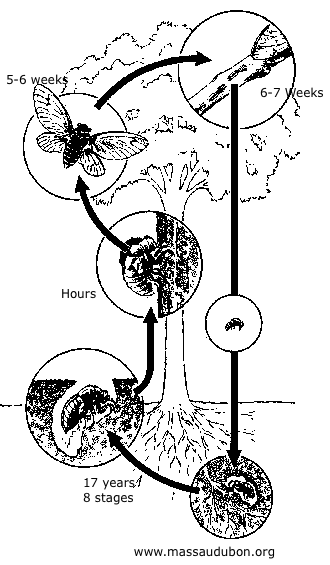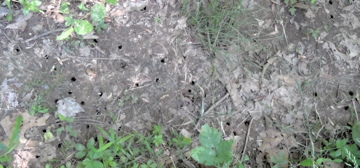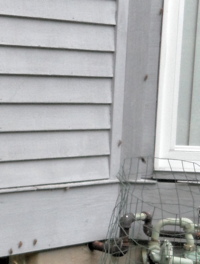 Science
Science
 Biology
Biology
 Cicadas
Cicadas
About 2,500 species of cicada have been described, and many remain to be described. Cicadas live in temperate-to-tropical climates where they are among the most-widely recognized of all insects, mainly due to their large size and unique sound.
They are in order Hemiptera, suborder Auchenorrhyncha and superfamily Cicadoidea.
 Periodical Cicadas (Genus Magicicada - the 13 and 17-year ones in North America) are much different from annual cicadas.
Periodical Cicadas (Genus Magicicada - the 13 and 17-year ones in North America) are much different from annual cicadas.
Broods show up in different places in different years.
The 17 year cicadas are more prevalent.
E.g. (1995, 2012, 2029) in TN, VA, WVA.
(1996, 2013, 2030, ...) in CT, GA, MD, NC, NJ, NY, PA, VA.
MD, NC, NJ, NY, PA & VA also had broods in 2004 and 2008, but the 2013 brood was the largest.
(1997, 2014, 2031, ...) in IA, IL, MO
The 13 year cicadas showed up in:
(1998, 2011, 2024, ...) in AL, AR, GA, IL, IN, KY, LA, MO, MS, NC, OK, SC, TN, VA
plus other years.
The farthest west any occurred was TX.
See the Brood Chart at CicadaMania.com for more.
 Nearly all cicadas spend years underground as juveniles, before emerging above ground for a short adult stage of several weeks to a few months. The seven periodical cicada species are so named because, in any one location, all of the members of the population are developmentally synchronized. They emerge as adults all at once in the same year.
Nearly all cicadas spend years underground as juveniles, before emerging above ground for a short adult stage of several weeks to a few months. The seven periodical cicada species are so named because, in any one location, all of the members of the population are developmentally synchronized. They emerge as adults all at once in the same year.
The nymphs of the periodical cicadas live underground, often at depths of 30 cm (1 ft) or more, feeding on the juices of plant roots.
The nymphs emerge in the Spring where they climb to a suitable place on the nearby vegetation to complete their transformation into an adult cicada. They molt one last time and then spend about six days in the leaves waiting for their exoskeleton to harden completely.
The empty shell of a Periodical Cicada (technically called an exuvia) remains where it was abandoned.
Adult periodical cicadas live only for a few weeks--by mid-July, all have disappeared.
Their short adult life has one purpose: reproduction. The males "sing" a species-specific mating song; like other cicadas. It sound creates a loud din (up to 100 dB) in many areas.
Hear the cicada song  at wikipedia.
at wikipedia.
You can pick them up quite easily (they won't harm you at all, they prefer plant sap!)
Concentrations reach up to 1.5 Million per acre.
They don't blend in and can't move while they are waiting for their exoskeleton to harden, so are easy targets for predators (birds, squirrels, snakes, lizards, raccoons, etc).
Their survival tactic is "predator satiation"; By coming out all at the same time, there are so many of them that the predators can eat them all.
After mating, the female cuts V-shaped slits in the bark of young twigs and lays approximately 20 eggs in each, for a total of 600 or more eggs.
fter about six to ten weeks, the eggs hatch and the newborn nymphs drop to the ground, where they burrow and begin another 13 or 17-year cycle.

Holes where the nymphs emerge Slits where eggs are deposited

|
  Nymph shells remain. |
Links:
Cicadas | Mass Audubon
Are Periodical Cicadas Coming to Your Town - Magicicada Broods and Brood Maps
17 years in the making, this spring's cicada invasion generates early buzz - nbcnews.com
Cicada Facts | U. MD
Periodical cicadas - Wikipedia
Cicada life cycle | jakesweb.tripod.com
View from the Cape: Cicadas
Cicada Molting/Eclosing Process at Massachusetts Cicadas (masscic.org)
